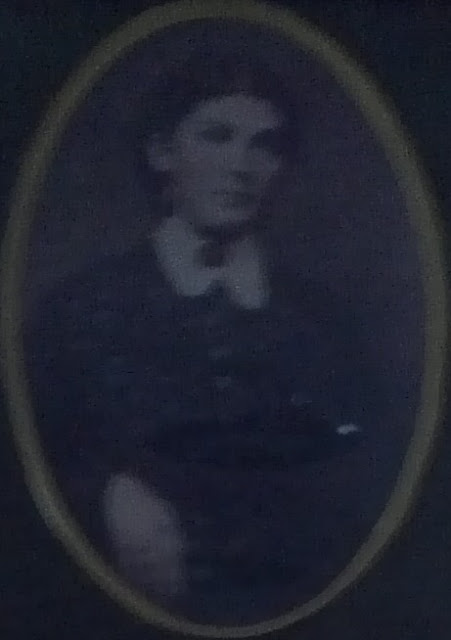 |
| Dora Evans Wolfe |
Richard Fuson first came to the new world from England in 1652 in hopes of finding rumored opportunities and seeking to own land. He took up residence in Hanover, VA and married a young woman named Elizabeth when he was in his 30s. With Elizabeth, he had several children over the span of roughly 20 years. His last son, William, was born in Hanover in 1715.
William also married a woman named Elizabeth, who was also born in Hanover, Virginia in 1715. William held a small farm and he also had interest in his father's business in the town of Hanover. (It's odd, but sometimes William is listed as "Fuston," though I am unsure why.) After William's father died, William took Elizabeth back to England to visit his father's family. While traveling in Wales, Elizabeth gave birth to John Fuson in 1736. The family then returned home to Hanover, Virginia for a time.
John Fuson grew up in Hanover, Virginia and married a woman named Elizabeth Wheeler, daughter of Thomas Wheeler and Phoebe Saxon. Elizabeth was 9 years younger than John and her father was reputed to be overbearing. John had several children with Elizabeth Wheeler, but several died very young. In 1760, they had a son named Thomas while living in Hanover.
Though John's father had a fine farm in Hanover, after the marriage to Elizabeth Wheeler, William sold his farm and William and his wife Elizabeth, John and his wife Elizabeth and their children used the money to purchase a huge land area near Amelia, Virginia, which is approximately 50 miles on the other side of Richmond away from Hanover. (It makes me wonder how overbearing and influential Papa Wheeler was.)
Thomas Fuson fought in the American Revolution which took him to an area near Mount Olivet, Kentucky. He loved the beauty of the area, especially in the more mountainous regions. Surviving the American Revolution, he was granted a land bounty of 800 acres in the Tri-State area of KY-TN-Va for his service to the new country. He married a woman named Rachel Permelia Robinson and broke the curse of the Elizabeths as wives. Rachel and Thomas had several children who scattered through the Kentucky region. Thomas and his wife moved to Big Clear Creek in Knox, Kentucky with one set of their children, where they died at the ages of 89 and 91 respectively.
Thomas and Rachel had a son named James Robinson Fuson, who was born in Green, Tennessee on his parent's land on December 31, 1800. People could be quite scattered on the large land plots obtained via cash or land bounties. When James was 15 or 16, the neighboring family had a daughter named Katie Lee. Over the years, he watched her grow up, and when she was 15, James married her. It was said that no man ever loved anyone as much as James loved Katie Lee, but she was frail.
Within the year, Katie Lee and James had a son named Bothican Fuson, however within three days, both Katie Lee and Bothican died. James was heart-broken and inconsolable. Family legend has it that he burned the small house in which he and Katie Lee lived before moving to a remote location in the mountains on the family land where he lived alone for approximately 10 years.
Now it is interesting to note that the last recorded Indian raid in Kentucky was 1793, but hunting parties continued for many years after that. After moving, James' nearest neighboring family's last name is Stanifer (or Staniford.) According to the story, there was a Blackfoot Indian hunting party that was caught in a flash flood which killed most of the Indians. (Other tribes known to the area have been Shawnee, Yuchi, and Blackfoot, but we were told the tribe was Blackfoot.) A lone Indian girl was found along the flood route and she was adopted by the Stanifer's. They named her Ruthy Jane and it is believed that she was born around 1825.
 |
| Ruthy Jane Stanifer |
Though James never left his remote location in the mountains prior to being quite old, he built Ruthy Jane a sturdy home and ensured his children received an education that included religion and etiquette. Granny spoke of going to see the James Fuson family home on the first time that she road in a car. Evidently the car twisted up a path on the mountain causing the adults to have to get out and push multiple times. Granny thought the family who lived there were some feudal mountain folks. Obviously the trip made an impact on her.
James doted on Mary Angeline, who was born in 1854 in Chenoa, Kentucky in the home of Ruthy Jane's family. She was beautiful to the point where suitors came calling from all over the area. According to the stories, when suitors called on her, James would put them to work for hours in exchange for allowing them to speak with Mary Angeline for just a few moments, but then he would send them away so they would not get caught in the dark on the mountain.
 | |
| Mary Angeline Fuson |
Shelton Evans accompanied Mary Angeline home along with several relatives of both Ruthy Jane and James, who were quite sure that the boy would be shot for turning James' only daughter's head. The couple married in a tiny chapel and there was a reception at James' home. An apple stack cake was served as a wedding cake, which later family members (Granny and Mom and probably Grandma Dora) viewed as "terribly country." To be fair, molasses and unrefined flours were much more common than white sugar and flour. Plus, I hear these cakes are really good. I have the list of ingredients without many instructions for this cake. I've never made it nor have I tried it, but I plan to make it for Thanksgiving or Christmas this year! So pictures will follow when I do.
Mary Angeline's Apple Stack (Wedding) Cake
Filling:
- 4 or 5 packed cups of dried apples
- 1 cup brown sugar, firmly packed
- a spoon of ground cinnamon - I'm guessing a teaspoon.
- a spoon of ground ginger - again, I'm going to guess a teaspoon.
- scant spoon of nut spice. I'm going to guess mace or nutmeg and maybe 1/2 teaspoon.
- water to match the apples so 4 or 5 cups
Layers:
- Bowl of flour more or less. I have no idea. I'll try with five cups of all-purpose flour and add if needed based on the other ingredients. The actual flour used here could be a lot of things, including acorn flour though.
- a spoon of baking soda - teaspoon
- a spoon of baking powder - teaspoon
- a spoon of salt -teaspoon
- large heap of shortening (I'll try with Crisco - perhaps 2/3 to 3/4 cup.)
- cup of granulated sugar - a precious commodity
- cup of molasses
- 2 eggs beaten
- cup of buttermilk
Okay, not much direction, but this is what I will do. Stir the dry ingredients together. Beat the sugar and shortening together. Add eggs and beat after each one. Then add dry ingredients alternating with buttermilk. The dough is supposed to be cookie-like so I assume stiff. I know that it is patted out in the skillets in like thin (1/2 inch, maybe) layers. I'll prick the dough all over and bake until done - maybe 10 or 15 minutes. (The reason is that the apple filling is supposed to soak in the cake layers as one takes them from the oven.) Once the cake is assembled, cover it and let it rest at room temp for two or three days before cutting.
I know that apple stack cakes are suppose to have an odd number of layers. Likely due to the religious connection of the holy trinity or the power of 7. I also know that it is rumored that people would bring layers to weddings to make a cake for a couple, but I don't think this can be true because it has to set and soak for several days. Likely something the mountain people made up to joke with out-of-area visitors who wanted the recipe. :)
Family legend also has it that James would not speak to either Mary Angeline or Shelton until Mary Angeline had a daughter of her own. At that point, all was forgiven!
























